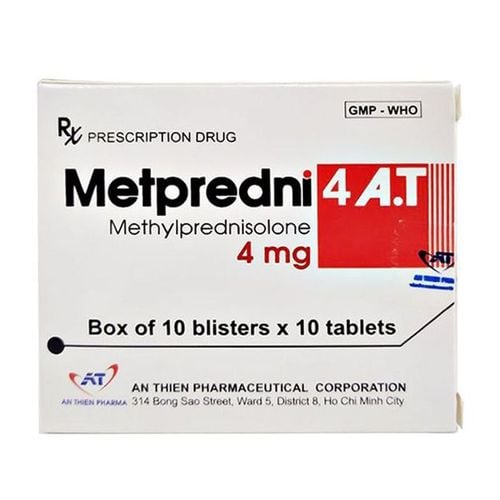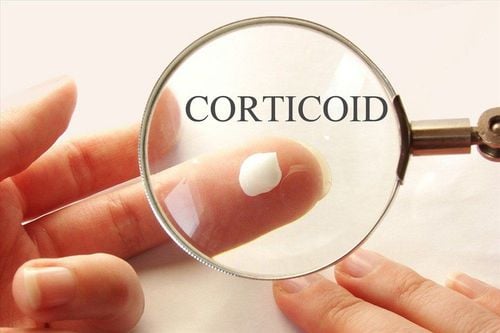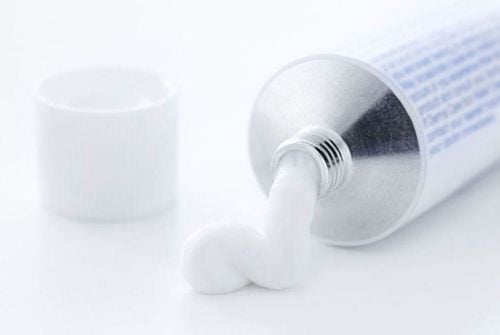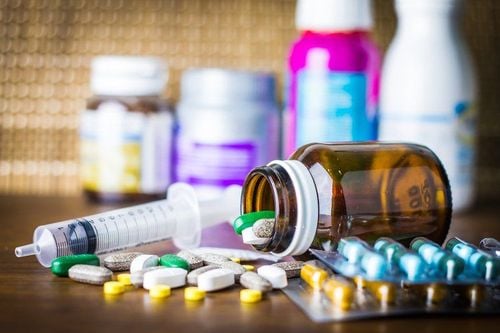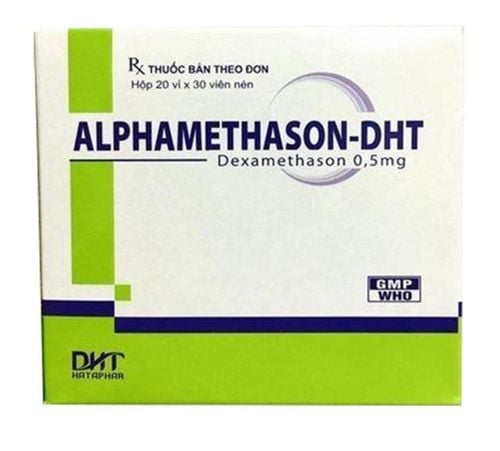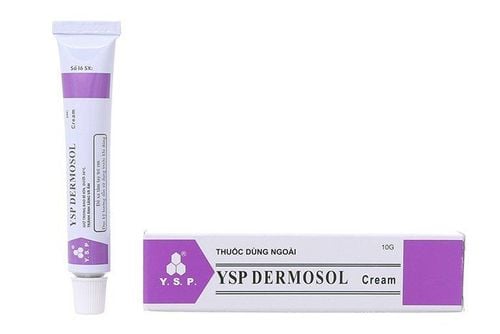This is an automatically translated article.
Daewondexmin is used in the treatment of rheumatic disorders, rheumatoid arthritis and systemic lupus erythematosus; skin diseases such as dermatitis, psoriasis and allergic conditions such as asthma, angioedema.
1. What effect does Daewondexmin have?
Daewondexmin has the main ingredients Betamethasone and Dexchlorpheniramine, belonging to the group of anti-allergic drugs, used in cases of hypersensitivity. Daewondexmin is prescribed by doctors to treat diseases such as:
Joint disease with symptoms such as rheumatism, bursitis, myositis, psoriatic arthritis... symptoms such as lupus erythematosus, scleroderma,... Daewondexmin is used in the treatment of severe allergic diseases such as seasonal or persistent allergic rhinitis, allergies accompanied by symptoms such as bronchial asthma, nasal polyps, inflammation. contact skin, bronchial asthma , atopic dermatitis (neuritis). Dermatological disease when experiencing psoriasis, discoid lupus erythematosus... Hormonal disorders with primary or secondary adrenal insufficiency, congenital adrenal hyperplasia, and hypercalcemia due to cancer, non-fissuring thyroiditis. Treatment of respiratory diseases: Loeffler syndrome in cases not controlled by other methods, pulmonary fibrosis, symptomatic sarcoidosis; berylium poisoning; in combination with chemotherapy in the treatment of acute and disseminated pulmonary tuberculosis; pneumothorax. Treatment of eye diseases such as allergic conjunctivitis, iritis, keratitis, allergic corneal ulceration, ocular herpes zoster, chorioretinitis, blepharitis, optic neuritis, Sympathetic ophthalmia, central retinitis, retrobulbar neuritis, sclerosing choroiditis, and anterior chorioretinal vasculitis diffuse posteriorly. Treatment of blood diseases: Spontaneous and secondary thrombocytopenia in adults; autoimmune hemolytic anemia; erythrocytopenia and hereditary anemia. Use in cancer treatment: Daewondexmin is a temporary treatment for acute leukemia in children and lymphoma in adults. Edema: With symptoms such as angioedema, diuretics or proteinuria do not cause uremia in primary nephrotic syndrome or lupus erythematosus. Mechanism of action:
The drug component Betamethasone in Daewondexmin is a synthetic corticosteroid, has a very strong glucocorticoid effect, Betamethasone has an effective use in anti-arthritis and anti-allergic, strong anti-inflammatory, used to treat disorders that are responsive to corticosteroids.
2. Dosage and how to use Daewondexmin
How to use: Daewondexmin is prepared in the form of tablets, used through oral administration.
Dosage:
The dose of the drug in each patient is different, depending on the health status, pathology, location and how well the body absorbs the drug. The use of Daewondexmin must be strictly adhered to as prescribed by the doctor. Patients can refer to the following dosage:
Dosage for adults and children over 15 years old take 1-2 tablets, 3-4 times a day. For children 8 from 14 years old, the starting dose is half a tablet to 1 tablet x 3-4 times a day. For children from 3-7 years old, the initial treatment dose is 1⁄4 to 1/2 tablet, 2-3 times a day. Contraindications:
Do not use Daewondexmin in cases of patients with systemic fungal infections, sensitive reactions to Betamethasone or allergic to other corticosteroid drugs or any of the components of Daewondexmin. Do not use the drug with infants and premature children, patients are taking MAO drugs. Absolutely avoid using Daewondexmin with people with mental illness, diabetes, stomach and duodenal ulcers in bacterial and viral infections.
3. Side effects of the drug Daewondexmin
Some common reactions when patients use the drug, these reactions are severe or mild depending on the dose and duration of treatment such as: Dizziness or nausea, heartburn, dry mouth, weakness, eating loss of appetite, headache, anxiety, polyuria, sweating, dysuria, dermatitis. Effects on the skin: Slows down wound healing; petechiae and ecchymosis; the appearance of a rash on the face; increased sweating; changes in skin test results; atopic dermatitis, urticaria; neurovascular edema. Effects on the nervous system: Convulsions; increased intracranial pressure after treatment; dizzy; headache. Effects on vision: Causes subcapsular cataracts, glaucoma, glaucoma, bulging eyes. Fluid and electrolyte disturbances with manifestations such as hypokalemia, potassium loss, alkalinity, fluid retention, congestive heart failure in susceptible patients, and hypertension. Effects on the digestive system: Risk of causing pancreatitis and peptic ulcer with symptoms of perforation or bleeding, abdominal distension, ulcerative esophagitis. Psychiatric effects: Common symptoms include lightheadedness; manifestations of severe psychological impairment; personality change; insomnia. Effects on the musculoskeletal system: Causes muscle weakness and corticosteroid-induced myopathies, worsening of myasthenia gravis, decreased muscle mass, pathological long bone fractures, vertebral depression, osteoporosis, aseptic necrosis femoral head and humerus head, ligament rupture. Endocrine effects: Causes menstrual disorders; Cushing-like syndrome; secondary adrenal and pituitary loss of response, particularly during times of stress; reduces carbohydrate tolerance; manifestations of latent diabetes, increasing the need for insulin or hypoglycemic agents in the treatment of diabetes. Other side effects include anaphylaxis or hypersensitivity reactions.
4. Be careful when taking Daewondexmin
Because the drug has an immunosuppressive effect, using corticosteroids at higher doses than necessary will often increase susceptibility to infections. Corticosteroids can reverse signs of infection and superinfection that may occur during treatment. Dosage should be adjusted as the disease improves and the dose should be reduced according to the individual response of the patient. Before stopping the drug, the dose should be reduced gradually, not suddenly. Daewondexmin should be used with caution in cases where the patient is experiencing problems such as emotional imbalance or psychotic tendencies; Nonspecific ulcerative colitis, if there is a possibility of progression to perforation, abscess or other pyogenic infection. Use caution in patients with congestive heart failure, recent myocardial infarction, hypertension, epilepsy, liver failure, glaucoma, hypothyroidism, osteoporosis. Care should be taken to use the drug in children because this case is prone to side effects, affecting the development of the child. In the case of patients taking Daewondexmin for a long time, it is necessary to monitor their health status regularly, when necessary, reduce the amount of sodium and add calcium and potassium. Long-term use of corticosteroids, including Daewondexmin, can lead to cataracts (especially common in children), glaucoma syndrome that damages the optic nerve and can promote secondary infection. in the eye due to fungal or viral attack. It is necessary to check the quality of the drug before use, the patient absolutely does not use the drug past the expiry date or the drug has problems such as wetness, color change. For pregnant and lactating women: Using Daewondexmin for pregnant women and mothers who are breastfeeding, patients should weigh the benefits of treatment with the harmful side effects to the fetus. or infants. Because the drug has the ability to be excreted through the placenta and persist in breast milk. There are also studies that show that the drug can affect the birth weight of the baby when the mother uses the drug for a long time during pregnancy. Do not use the drug for driving and operating machinery: Because the drug causes drowsiness and somnolence, affecting the ability to work.
5. Drug interactions
Drug interactions will affect the therapeutic effect of the drug or increase the harmful side effects to the patient's health. Therefore, in the course of treatment, the patient should inform the doctor or pharmacist of the drugs that have been used recently. Here are some drugs when combined with Daewondexmin will cause interactions:
When used in combination with non-steroidal anti-inflammatory drugs, potassium-depleting diuretics, Phenobarbital, coumarin-type anticoagulants, Phenytoin, Rifampin , Ephedrine, cardiac glycosides: Increases the risk of unwanted side effects, affecting the effectiveness of the drug. Abametapir: The serum concentration of the drug may be increased when it is combined with Abametapir. Abatacept: The risk or severity of side effects may be increased when the drug is combined with Abatacept. Abemaciclib, Acalabrutinib: The metabolism of these two drugs may be increased in combination with the betamethasone component. Acarbose: The risk or severity of hyperglycemia may be increased when Betamethasone is combined with Acarbose. Aceclofenac: The risk or severity of gastrointestinal irritation may be increased when Betamethasone is combined with Aceclofenac. Aminophenazone: The risk or severity of gastrointestinal irritation may be increased when Betamethasone is combined with Aminophenazone. Acenocoumarol: Betamethasone may increase the anticoagulant activity of Acenocoumarol. Acipimox: Increased risk or severity of myopathy, rhabdomyolysis, and myoglobinuria when Betamethasone is combined with Acipimox. Alclofenac: The increased risk or severity of gastrointestinal irritation may be increased when Betamethasone is combined with Alclofenac. Aldesleukin: The therapeutic efficacy of Aldesleukin may be reduced when used in combination with Betamethasone. Above is information about uses, dosage and precautions when using Daewondexmin. To ensure health safety, patients do not arbitrarily buy Daewondexmin medicine to treat at home without a doctor's/pharmacist's indication and prescription.




